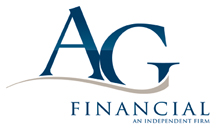Investment Philosophy
From having worked for large brokerage firms, we found the model often used to provide investment recommendations for clients was a fractured one. The focus was on shareholders, share price, and proprietary products. At AG Financial, our allegiance is to our clients’ best interest. We can't control the stock market or the global economy, but we can help control three of the most critical aspects of any investment allocation:
- Downside Risk
- Taxes
- Fees
Downside Risk
Since the 1920s, the stock market has posted an average annual return of around 10%, slightly higher for small-cap stocks. However, these returns have never been consistent and are, therefore, deceiving. Periods of double-digit percentage returns have often been followed by years of double-digit percentage losses. Unlike the years of positive investment results, it's the years of loss that have had the largest impact on an individual’s ability to achieve lifelong goals.
Suppose you enter retirement and suffer a 30% loss in your portfolio. Further assume there is no income or savings to offset the losses. This most likely will change the way you live in retirement or possibly cause you to return to work. On the other hand, the upside is easy. The bull market is the proverbial rising tide that lifts all ships. It's when the tide recedes again that sound downside risk management becomes essential.
Keep in mind that investors must consider their risk tolerance and investment objectives to stay invested during down markets. Past performance does not guarantee future results and investing during any market cycle poses risks, including loss of principal.
Taxes
Assume for a moment, your financial planning process has already been a success. You’ve managed risk. Your fees are low. Thanks to generally good market results, your assets have grown handsomely over time. Now you must factor in taxation. Current tax structures have the power to take 35% or more of your annual gains. What is more disconcerting is that many investment vehicles are grossly inefficient at providing shelter from these far-reaching laws.
Just as an engineer must evaluate an architect’s design, we at AG Financial are committed to evaluating the tax impact of every recommended strategy. We realize that it’s just as important to hold on to what you earn as it is to grow your wealth over time. Whether it’s your investments, an asset in your estate, or a scheduled withdrawal from a qualified plan, we understand that you have labored your entire life to accumulate this wealth, and that you expect your financial advisor to work just as hard to protect it.
Fees
If the stocks in your portfolio rose 10% annually, you might be pleased with the return, but how much of that return will be reduced by fees, transaction costs, loads, and, if the plan is outside a tax-sheltered retirement account, taxes? After you calculate these costs, your 10% return could be reduced to 7% or even less!
Some might say, “Well, 7% is at least 70% of 10%. I'm only losing 30% of what I could have had if there were no costs.” However, when you consider the impact of compounding, the loss is substantially greater than that.
Assume in the first year, a portfolio valued at $100,000 grows 7% ($7,000) versus 10% ($10,000) if there were no costs. You would keep 70% of the gain, giving up 30% to costs. But now look at what happens when you consider compounding. After 40 years, your $100,000 will have grown to $1,490,000 at 7% compared to $4,520,000 at 10%. You are losing $3,030,000! That is not a mere 30% of the $4,420,000 gain you could have had, it's 68%. In this example, that makes you, in effect, just a 32% partner in your own success. (Example is for illustrative purposes only, not reflective of specific investment product nor is it a prediction or guarantee of actual results.)

